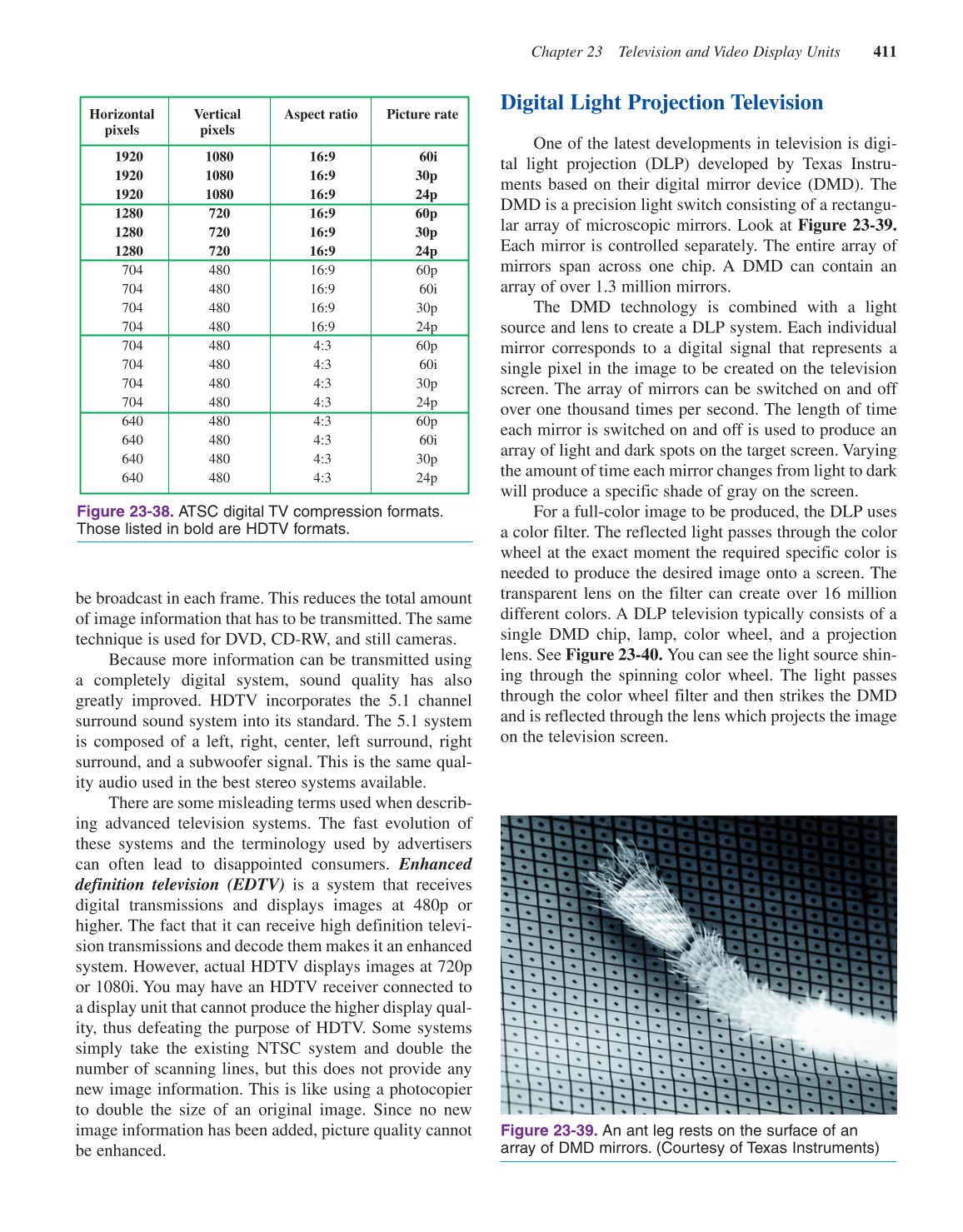be broadcast in each frame. This reduces the total amount
of image information that has to be transmitted. The same
technique is used for DVD, CD-RW, and still cameras.
Because more information can be transmitted using
a completely digital system, sound quality has also
greatly improved. HDTV incorporates the 5.1 channel
surround sound system into its standard. The 5.1 system
is composed of a left, right, center, left surround, right
surround, and a subwoofer signal. This is the same qual-
ity audio used in the best stereo systems available.
There are some misleading terms used when describ-
ing advanced television systems. The fast evolution of
these systems and the terminology used by advertisers
can often lead to disappointed consumers. Enhanced
definition television (EDTV) is a system that receives
digital transmissions and displays images at 480p or
higher. The fact that it can receive high definition televi-
sion transmissions and decode them makes it an enhanced
system. However, actual HDTV displays images at 720p
or 1080i. You may have an HDTV receiver connected to
a display unit that cannot produce the higher display qual-
ity, thus defeating the purpose of HDTV. Some systems
simply take the existing NTSC system and double the
number of scanning lines, but this does not provide any
new image information. This is like using a photocopier
to double the size of an original image. Since no new
image information has been added, picture quality cannot
be enhanced.
Digital Light Projection Television
One of the latest developments in television is digi-
tal light projection (DLP) developed by Texas Instru-
ments based on their digital mirror device (DMD). The
DMD is a precision light switch consisting of a rectangu-
lar array of microscopic mirrors. Look at Figure 23-39.
Each mirror is controlled separately. The entire array of
mirrors span across one chip. A DMD can contain an
array of over 1.3 million mirrors.
The DMD technology is combined with a light
source and lens to create a DLP system. Each individual
mirror corresponds to a digital signal that represents a
single pixel in the image to be created on the television
screen. The array of mirrors can be switched on and off
over one thousand times per second. The length of time
each mirror is switched on and off is used to produce an
array of light and dark spots on the target screen. Varying
the amount of time each mirror changes from light to dark
will produce a specific shade of gray on the screen.
For a full-color image to be produced, the DLP uses
a color filter. The reflected light passes through the color
wheel at the exact moment the required specific color is
needed to produce the desired image onto a screen. The
transparent lens on the filter can create over 16 million
different colors. A DLP television typically consists of a
single DMD chip, lamp, color wheel, and a projection
lens. See Figure 23-40. You can see the light source shin-
ing through the spinning color wheel. The light passes
through the color wheel filter and then strikes the DMD
and is reflected through the lens which projects the image
on the television screen.
Chapter 23 Television and Video Display Units 411
Horizontal
pixels
1920 1080 16:9 60i
1920 1080 16:9 30p
1920 1080 16:9 24p
1280 720 16:9 60p
1280 720 16:9 30p
1280 720 16:9 24p
704 480 16:9 60p
704 480 16:9 60i
704 480 16:9 30p
704 480 16:9 24p
704 480 4:3 60p
704 480 4:3 60i
704 480 4:3 30p
704 480 4:3 24p
640 480 4:3 60p
640 480 4:3 60i
640 480 4:3 30p
640 480 4:3 24p
Vertical
pixels
Aspect ratio Picture rate
Figure 23-38. ATSC digital TV compression formats.
Those listed in bold are HDTV formats.
Figure 23-39. An ant leg rests on the surface of an
array of DMD mirrors. (Courtesy of Texas Instruments)
